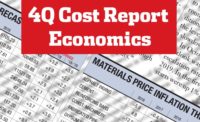As 2021 closes, the construction industry continues to cope with cost challenges related to labor, materials shortages and inflation. The average cost increase in 2020 through 2021 was 4.73%, says Julian Anderson, president of industry cost consultant Rider Levett Bucknall, adding that bid construction costs have risen 7.42%.
“Inflation, particularly as it relates to construction materials, is having a significant negative impact on construction starts and leading to delays in projects breaking ground,” adds Richard Branch, Dodge Construction Network chief economist. But he sees supply catching up with demand for many materials in 2022.
“Industry-level data is suggesting that factories are slowly getting production levels back to where it was before the pandemic,” he says. “If that trend continues, and we start to see improvements on the port and logistics front, that should mean a more favorable pricing environment in the second half of 2022.”
Early Stage Planning
The Dodge Momentum index, which tracks non-residential activity, “is near a 14-year high led by a groundswell of commercial and institutional projects entering the early stage of the planning process,” says Branch, who says the recently passed Infrastructure and Jobs Act will also spur an uptick in non-building construction.
Dodge says non-residential building is up 11% through the first 11 months of the year, which continues to be largely driven by warehouse and manufacturing construction. Hotel and office work, hit hardest by the pandemic, remains slow to recover. Overall non-building work increased 1% in the past year, due to flat funding levels prior to the new act’s passage. The environment and utility sectors have seen the most growth, while road and bridge construction declined.
Residential construction increased 20% through November. “As the year started, the single-family sector was robust while multifamily starts were struggling,” says Branch. “As the year progressed, the roles are reversed with multifamily starts surging over the last few months.”
Lumber Cost Drop in 2022
On the materials side, lumber prices remain volatile. “Following lumber’s historic collapse in pricing over the summer, volatility has plagued the North American softwood lumber market,” says Frank Hoffman, consulting principal at IHS Markit. “Until about three weeks to one month ago, the market was in surplus as demand had cooled off significantly from the highs of spring.”
Prices have increased in the past month, which Hoffman attributes largely to storms and excessive flooding beginning in November in British Columbia. About 14% of U.S. softwood lumber comes from the province, so “fears about a potential supply disruption have fueled panic buying,” he adds.
Despite the current increase, IHS Markit expects prices to decline in 2022. The fourth quarter forecast predicts a 29.2% drop in 2022 after rising 38.7% in 2021. Plywood is expected to decline 30.6% after a 45.8% increase this past year. “We expect the market to be substantially better supplied in the first quarter of 2022, and this will result in prices coming back down to where they were in October and early November,” says Hoffman.
.jpg?1671747499)




.jpg?height=200&t=1671747499&width=200)
Post a comment to this article
Report Abusive Comment